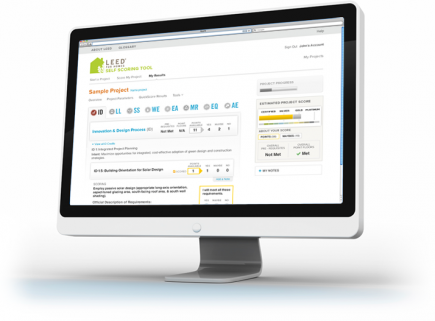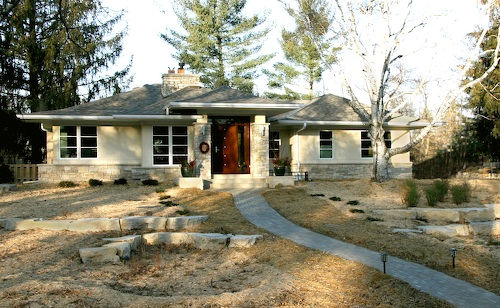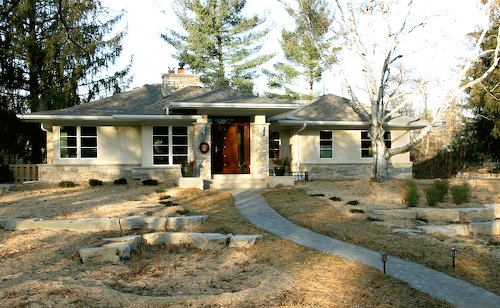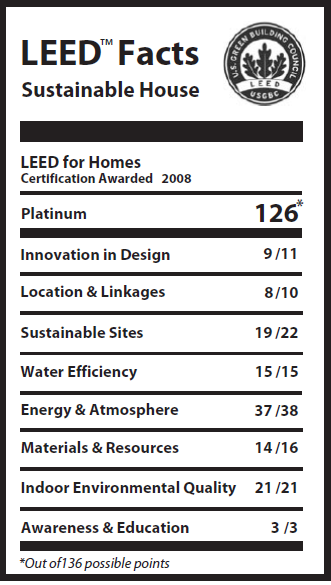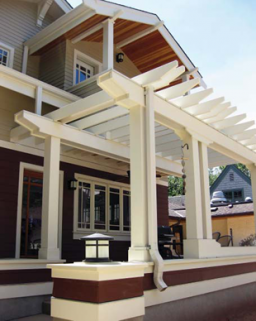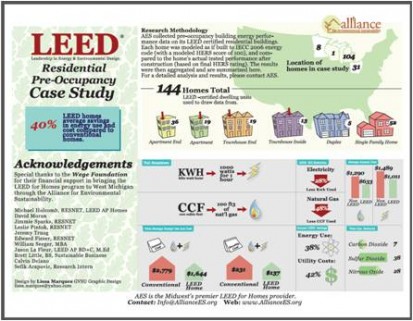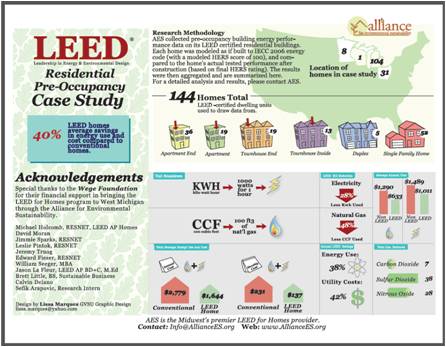
A new home along the Kenilworth Lagoon – reminiscent of a modest Arts and Crafts bungalow – is scaled to fit the specific needs of the homeowner and tailored to match the scale and character of the neighborhood. Designed by Domain Architecture & Design®, Minneapolis, MN, the interior of this single-family, detached bungalow feels large and spacious, despite it small footprint. This LEED for Homes registered project also benefited from a whole-structure, whole-site, integrated design approach utilizing emerging, as well as proven, sustainable technologies and construction systems. Sustainable design strategies were integrated in ways that harmonize cutting-edge technologies with a traditional aesthetic.In September, the Project’s strengths were acknowledged through its selection to the prestigious ’09 AIA-MN Homes By Architects Tour. A distinguishing feature of the home is its construction from structural insulated panels (SIPs). These panels, which were custom built off-site, sandwich insulation between a structural skin of two sheets of OSB
(oriented strand board) structural skin. This eliminates on-site waste common with typical wood framing, increases construction efficiency, and creates a high performance building that is stronger, quieter and considerably more energy efficient than homes of traditional construction. The use of SIPs, as well as high-efficiency windows, appliances, fixtures, and heating and air conditioning systems, will drastically reduce energy use and energy bills. In fact, with a HERS Index of 49, this home is projected to be 51% more energy efficient than its built-to-code-standard analogue would be. Moreover, the indoor air quality of the home should far exceed that of a conventional home, thanks to the use of low-VOC paints, formaldehyde-free cabinetry, and integrated moisture control measures that will limit mold and mildew build-up. The landscape design retains and infiltrates 100% of an ‘average’ rainfall onsite, allowing the owner to defray costs via municipal stormwater abatement credits and minimizing use of the site’s high efficiency irrigation system. This is the result of utilizing only no-mow turf; non-invasive, drought-tolerant,native flora; numerous infiltration devices; and pervious-concrete ‘trapping’ strategies in the driveway.For every square foot of impervious concrete hardscape found within the site, there is a square foot of
moisture control measures that will limit mold and mildew build-up. The landscape design retains and infiltrates 100% of an ‘average’ rainfall onsite, allowing the owner to defray costs via municipal stormwater abatement credits and minimizing use of the site’s high efficiency irrigation system. This is the result of utilizing only no-mow turf; non-invasive, drought-tolerant,native flora; numerous infiltration devices; and pervious-concrete ‘trapping’ strategies in the driveway.For every square foot of impervious concrete hardscape found within the site, there is a square foot of
pervious (permeable) concrete offsetting it. Domain is committed to green building, with designers that are LEED accredited, and completed projects that have been recognized for excellence in sustainable design – such as the renovation of the Pillsbury Library in Northeast Minneapolis (LEED-NC v2.2 Gold). For more information on building a new home or renovating your existing home in a way that reduces energy use, limits waste, and provides
a healthy indoor environment, please go to the Domain website at www.domainarch.com
 Project Particulars
Project Particulars
Total Property Area: (in Square Feet) 5570
Gross Home Square Footage: (in Square Feet) 3633
Total Home Footprint: (in Square Feet) 1337
Surface parking spaces: 0
Structure Parking Spaces: 2
Undisturbed Site Area: 0
Site Context/Setting: Urban
Site Conditions: Previously Developed
Green features and highlights:
� Fly Ash (recycled from coal power plants) used to strengthen the foundation concrete.
� SIPs (Structural Insulated Panels) used for the exterior envelope (walls and roof).
� Interior walls constructed with finger-jointed studs; and floor trusses are open-web type.
� Cabinetry & moldings constructed from FSC (Forest Stewardship Council) and urea-formalde
hyde free wood products.
� Project’s waste management plan facilitated a 67% landfill diversion rate for construction
waste removals.
� Appliances, ceiling fans, and bathroom fans are Energy Star rated.
� Lighting circuits are dimmable, and 80% of the lamps are Energy Star CFL’s.
ARCHITECTURE & DESIGN®
domain
� The plumbing system utilizes a central-manifold plumbing system to conserve water and to equalize pressure throughout system. � Plumbing fixtures (lavatories, showerheads, and toilets) are all high efficiency fixtures. � A heat recovery system provides continuous ventilation of fresh exterior air into the home. � Individual forced-air registers are pneumatically controlled from the furnace room to balance airflow throughout the home. � The fireplace and energy efficient furnace are direct-vented, and the energy savingr water heater is power-vented. � Landscaping includes three rain gardens, drought resistant flora, and no-mow turf. � The driveway’s outer concrete bands slope inward, directing water to the permeable center section, with a crushed rock field below. Water then percolates into the lower rain garden. � The irrigation system includes a zone controller, drip irrigation, and a rain delay controller.
Exterior General Information:
Roof Shingles: Barkwood by GAF-ELK
Front Door: TruStile
Front Door Hardware: Baldwin
Garage Doors: 9700 Series by Wayne Dalton
Exterior Material: James Hardie Lap Siding
Mechanical System: Paul Stafford Electric
Structural Insulated Panels (SIPs): Extreme Panel Technologies
Interior General Information:
Floors: Hickory by Schaefer Hardwood Floors
Cabinets/Millwork: Timber Creek Cabinets
Paint Colors: BEN by Benjamin Moore
Fireplace: Sweet Dreams by Lopi
Fireplace Surround: Meredith Tile
Interior Door Hardware: Baldwin
Tile – Fireplace Surround and Kitchen Backsplash: Meredith Tile
Tile – Entry Hall, Mud Room, and Bathrooms: Baoding Slate, Copper Rust slate, Jinshan Bone, Jinshan
Caramel Baoding Crème Yuma, and Banning Listello by Tile Shop
Bathroom Fixtures: Kohler
Toilets: Karsten by Sterling Kitchen
Range: Kenmore
Hood: Vent-A-Hood, Stainless Steel
Microwave: Kenmore
Dishwasher: Bosch Integra 500 series
Ref/Freezer: Kenmore
Kitchen Sink: Blancowave Plus by Blanco
Countertops: Maple Butcherblock by John Boos
Laundry Washer/Dryer: Epic by Maytag
Countertop and backsplash: LG, Confetti Quartz
Design Team: Domain Architecture & Design®, Inc., Minneapolis, MN
LEED Consultant / Project Team Leader: Mike Everson, LEED AP BD+C
Landscape Architect: Brubaker Landscape Designs
General Contractor: Reuter Walton Construction

